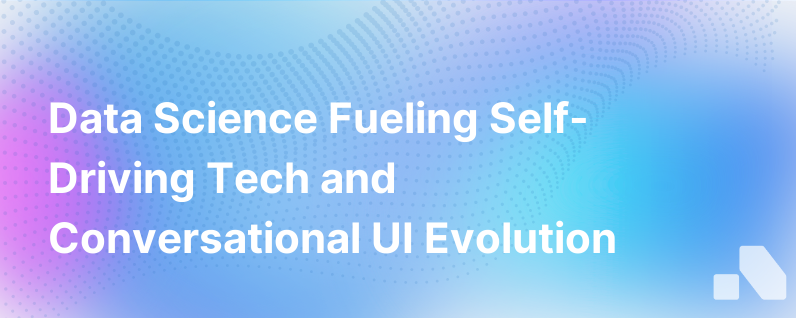
In the dynamic landscape of technology, two trends have particularly captivated the imaginations of innovators and consumers alike: the evolution of self-driving vehicles and the rise of conversational user interfaces (UI). The synergy between these two domains is underpinned by the monumental strides in data science, which serves as the linchpin for both advancements. In this deep dive, we elucidate how data science catalyzes the progression of autonomous vehicles and conversational interfaces, reshaping our interaction with technology and the world around us.
The Role of Data Science in Self-Driving Vehicles
The concept of self-driving cars, once confined to the realm of science fiction, is now on the verge of mainstream adoption, thanks to breakthroughs in data science and machine learning. Autonomous vehicles harness vast quantities of data from their surroundings using an array of sensors, including LIDAR, radar, and cameras. This deluge of real-time information presents a formidable challenge: how to process and interpret it effectively to make split-second driving decisions.
Fuelling Machine Perception
At the forefront of self-driving technology is the application of advanced machine learning algorithms that empower vehicles with the ability to perceive and comprehend their environment – a necessity for making informed decisions. Data scientists are continually refining these algorithms to enhance their predictive accuracy, drawing from massive datasets that represent myriad driving conditions and scenarios.
Optimizing Decision-Making Processes
Self-driving applications rely on sophisticated decision-making models, pivotal for evaluating potential actions and executing maneuvers safely. The employment of reinforcement learning, a subset of AI that operates on the principle of trial and error, is instrumental in honing these models. Through rigorous simulation and analysis, data science ensures that vehicles learn from their experiences, iteratively improving their judgment.
Ensuring Cybersecurity and Privacy
The interconnectedness inherent in autonomous vehicles introduces vulnerabilities to cyber threats and privacy breaches. Data science not only provides the security architecture to protect against such risks but also ensures that data handling complies with stringent privacy regulations. By safeguarding sensitive information, data science builds trust in the technology's reliability and integrity.
The Rise of Conversational UI
Conversational UI represents another vanguard of technological advancement, with applications ranging from customer service chatbots to virtual personal assistants like Siri and Alexa. The symbiosis between conversational UI and data science is profound – data is both the input and the fuel for the continual enhancement of these interfaces.
Natural Language Processing and Understanding
The efficacy of conversational UI hinges on natural language processing (NLP) – the ability of machines to understand and respond to human languages. Data science advances NLP through the analysis of vast textual and speech datasets, enabling algorithms to discern the nuances of language, including semantics, syntax, and sentiment. Over time, machine learning models undergo refinement, allowing for more natural and context-aware interactions.
Personalization and Predictive Analytics
A conversational UI's ability to provide personalized user experiences stands as one of its most compelling features. Data science drives this personalization through the analysis of user data, understanding preferences, and predicting needs. Machine learning algorithms can tailor responses and proactively offer assistance, forging a more intuitive and engaging experience.
Accessibility and Inclusivity
Conversational UIs also play a crucial role in making technology more accessible and inclusive. They offer an intuitive form of interaction that can transcend traditional barriers, such as physical disabilities or literacy challenges. Data science contributes to this by enabling conversational systems to learn from diverse datasets, ensuring they cater to a wide array of users and adapt to individual needs.
Challenges and Opportunities Ahead
Ethical Considerations and Bias Mitigation
As data science continues to underpin these technologies, it is imperative to address ethical concerns. Bias in machine learning models can lead to unfair or discriminatory outcomes, particularly if the training data itself is biased. Efforts in data science are geared towards developing fair and transparent algorithms, ensuring that self-driving cars and conversational UIs serve all individuals equitably.
Data Governance and Regulation
There is also an increasing focus on data governance and the regulatory framework within which these technologies operate. The stewardship of copious amounts of personal data necessitates strict regulation to protect user privacy, promote algorithmic accountability, and prevent misuse. Legislators, technologists, and data scientists must collaborate to establish standards and guidelines that encourage innovation while safeguarding public interests.
The Intersection of Self-Driving and Conversational UI
Looking forward, the intersection of self-driving applications and conversational UI promises to redefine the paradigms of human-machine interaction. Imagine a scenario where an autonomous vehicle not only transports you to your destination safely but also interacts with you in a conversational manner, adjusting settings to your preferences and assisting with your daily tasks. The convergence of these technologies, powered by data science, points to an exciting future that's both seamless and interconnected.
Conclusion
In conclusion, the applications of data science in self-driving technology and conversational UIs showcase a promising vision for the future. As we stand on the threshold of these technological marvels becoming an integral part of daily life, the onus lies on data scientists, developers, and industry leaders to responsibly harness the power of data while navigating the complex ethical and regulatory landscape. As we adapt to these changes, it is incumbent upon us to ensure that these innovations champion safety, efficiency, and above all, the betterment of humanity.